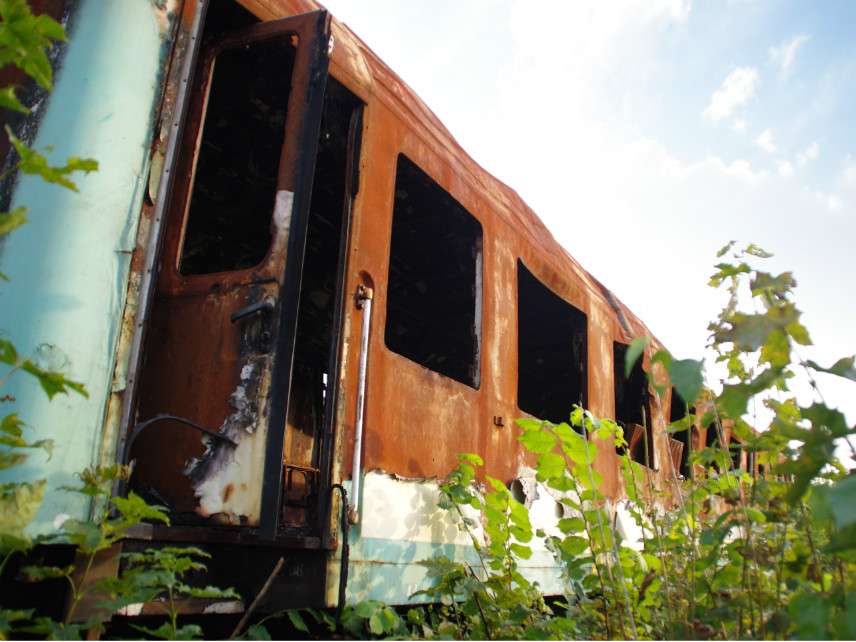Fire, Earth, and Water Visit Apocalyptic Delays on Nation's Rail Lines
Are the endtimes nigh for public transit?

Man's hubris can be the catalyst for a little divine humbling, from King Nebuchadnezzar and the builders of the Tower of Babel to today's overly ambitious urban transit agencies.
On Monday a rain storm caused a flood of biblical proportions in New York City's subway system, shutting down service at two stations for over an hour and causing service changes and delays on six rail lines.
Doused and disaffected riders took to Twitter to express their anger at the delays in general and at Gov. Andrew Cuomo in particular. Cuomon's Subway Action plan was supposed to whip the long-troubled transit system into shape.
scenes from 145th st/broadway. @NYCTSubway @MTA @NY1 #justalittlerain pic.twitter.com/vUYed8Se6g
— josh guild (@jbguild) April 16, 2018
.@NYGovCuomo Fix the subways. cc: @2AvSagas @CynthiaNixon pic.twitter.com/3jJb9Ht1BX
— Bret Hyde (@BretHyde) April 16, 2018
A similar situation was playing out on the West Coast, where heavy rains caused a mudslide onto some tracks just north of Seattle. This earthen disaster has shut down commuter rail transit between Seattle and the nearby community of Everett for 48 hours while the track is being cleared. This is not the first time this has happened recently.
Now it appears these apocalyptic signs are surfacing in belly of the beast: Washington, D.C.
This morning, smoke and a small fire at the Farragut North rail station caused service disruptions and delays, thanks to what the D.C.-area transit agency WMATA reports as "electrical current taking a wayward path, resulting in sparks/arcing from the trackbed."
Taken individually, these earth-, water-, and fire-caused delays would be just another routine inconvenience. Taking them together, let's declare them a sign that the transit endtimes are nigh.
Biblical portents aside, Randal O'Toole of the Cato Institute recently predicted a coming "transit apocalypse," to be ushered in by what he called the "four horsemen" of lower energy prices, growing maintenance backlogs, unfunded pension liabilities, and the rise of ride-sharing services such as Uber and Lyft.
Combined with the potential of driverless cars, O'Toole said, these forces could mean that "outside of a few very dense areas, such as New York City, transit will be extinct by the year 2030."
Whether the fall of transit will happen that fast is open to debate. But it is undeniable that the problems that O'Toole identifies, and which are in part responsible for this week's disruptions, will continue to see commuters flee mass transit systems for the more nimble and customizable services offered by ride-sharing services and, in time, by driverless cars.
New York's subway system has seen the number of trips taken on it fall by more than 30 million since 2015, even as the city added both jobs and people. D.C.'s Metro has seen an even more pronounced decline, with a 12 percent drop in trips taken from 2016 to 2017.
Seattle's transit system is an exception, with the booming city seeing a 4.7 million increase in trips taken on public transit. Nevertheless, its light rail lines are still undershooting their ridership predictions, and the city is still adding cars as fast as it is adding people.
Nationwide, ridership is down most everywhere.
Part of the reason for this marked decline in ridership in places like New York and D.C. is deteriorating service. New York's subways have seen on-time arrivals plummet to below 40 percent on some lines, and overcrowded cars are quickly becoming the norm.
D.C. residents, meanwhile, have had to suffer collisions, derailments, fires, constantly inoperable escalators, and reduced service to allow for long-deferred maintenance to take place.
The failures of public transit have led commuters to opt for ride-sharing services in droves. According to an October 2017 study by the Institute of Transportation Studies at the University of California, Davis, some 30 percent of adults in urban areas report using ride-hailing services, causing a 6 percent reduction in public transit use.
Ride-sharing offers a comfortable and customizable service that takes you directly to your destination at a time of your choosing. Mass transit, conversely, often only takes you from near point A to near point B. The inconvenience is compounded by any maintenance problems, since problems on one segment of track will affect service across the entire system.
That is certainly the case in D.C. today, where the fire at the centrally located Farragut North station—reportedly caused by a "maintenance issue"—has caused delays all up and down heavily trafficked line, and thus an exodus of riders.
It's just me. #wmata pic.twitter.com/Lm6Knkwd9a
— JP (@powerinva) April 17, 2018
In situations like this, ride-sharing is a nimble solution for stranded commuters. The coffee shop where I wrote this article after D.C.'s transit delays postponed my morning commute was filled with other Red Line refugees, a good portion of whom were calling Uber and Lyft cars to try to make it to work on time.
The maintenance and natural disasters that have wreaked havoc on the nation's mass transit systems this week aren't really divinely inspired. But they're still a reminder of both the coming, totally man-made transit apocalypse, and of what will replace it.
Rent Free is a weekly newsletter from Christian Britschgi on urbanism and the fight for less regulation, more housing, more property rights, and more freedom in America's cities.
Show Comments (109)